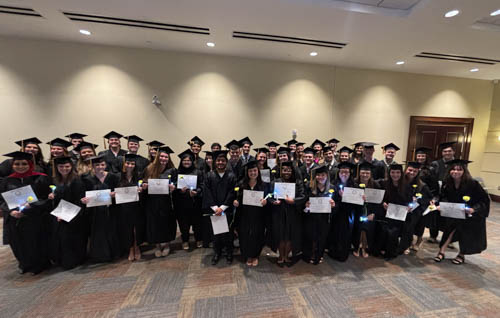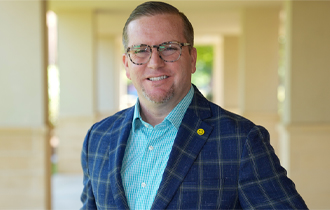Music Professor Hand Crafts 17th-Century Replica Trumpet
Posted on March 12, 2018
While on sabbatical in the fall of 2015, Dr. Peter Wood spent five solid days in Bloomington, Ind., hammering pieces of sheet metal.
And hammering. And hammering. And hammering.
As a result, Wood’s hand-crafted replica of a 17th-century natural trumpet now hangs on the wall of his University of South Alabama office, and the music professor, brass ensemble coach and renowned trumpeter marvels daily at the instrument’s simultaneous simplicity yet undeniable role in the development of the modern-day trumpet.
“Having built and learned to play the natural trumpet over the course of this project has really opened my eyes to the value of such study, and now I am able to share many of those benefits with my students,” said Wood, adding, “It improves their physical coordination, broadens their horizons and gives them a greater understanding of what we do — and, perhaps more importantly, why we do what we do.”
Wood, whose lifelong love affair with the trumpet began more than 40 years ago, has been teaching the instrument, its history and cultural significance for more than two decades, including the past 13 years in USA’s department of music. So he jumped at the chance to reverse roles and play student, participating in the annual International Trumpet-making Workshop as one of only 10 participants in the intensive and prestigious clinic that also included a member of the revered Metropolitan Opera Orchestra.
Working primarily by hand and bound by “historical principles,” the workshop’s sole assignment was to create a natural trumpet based on an original built in Nuremburg by Hanns Hainlein in 1632.
“We started with a flat piece of brass sheet metal and used only historical manufacturing methods, so there was virtually no machinery involved. We did a great deal of hand hammering and using blow torches. It was a tremendous amount of fun,” Wood said.
“We started with a flat piece of brass sheet metal and ... did a great deal of hand hammering and using blow torches. It was a tremendous amount of fun.”
The work was overseen by Richard Seraphinoff, a maker of natural horns since 1983 and modern horn and natural horn professor at Indiana University; Robert Barclay, a British maker of natural trumpets since the 1970s and author of “The Art of the Trumpet-maker;” and Michael Münkwitz, a maker of natural trumpets and other brass instruments and owner of Rostock, Germany-based Musik Münkwitz. Wood’s involvement was funded by an award from the USA Office of Research and Economic Development to support arts and humanities scholarship.
Aside from its nine-foot length, a natural trumpet differs primarily from its modern-day cousin in that it lacks valves that Wood says were later introduced around 1815 to improve accuracy and facilitate the playing of melodies in a comfortable range.
Wood’s historical replica allows him to illustrate how the physics of the natural trumpet accommodated only about 10 notes, whereas modern trumpets via the use of valves can produce about 35 notes, a full chromatic scale. The addition of valves at the time of the industrial revolution eliminated the need to switch among multiple trumpets to perform required key changes, made it easier to play melodies with accuracy and confidence, and enabled 19th-century composers to write more complex and exciting trumpet parts.
Stress on the embouchure, or the formation of the lips and cheek muscles required to play a brass instrument, is much more taxing on the natural trumpet. Even the most casual practice can quickly improve a player’s technique on a modern trumpet, Wood said.
“To me the biggest benefit is the physicality of it. In order to play the natural trumpet well, you have to have a great deal of control in your lips and cheek muscles, as well as a high degree of coordination with air speed. The slightest miscue in either area results in completely wrong notes on the natural instrument,” he said.
"The slightest miscue in either area results in completely wrong notes on the natural instrument.”
The 2011 recipient of the Andy and Carol Denny National Alumni Association Excellence in Teaching Award, Wood also won the USA College of Arts and Sciences Excellence in Teaching Award in 2007. He serves on the International Trumpet Guild board of directors and as the ITG publications editor, which includes oversight of the quarterly ITG Journal.
Wood earned his bachelor’s degree in music education from the University of Illinois, his master of music degree in trumpet performance from the University of Wisconsin-Madison and his doctorate in trumpet performance and literature from Indiana University-Bloomington.
Without question, Wood said, his foray into natural trumpet making has only reinforced his passion for an instrument that has unequivocally defined his life. That passion – and its historical roots – is something he seeks to promote in his students through his own enthusiasm and example.
“Honestly, I just can’t imagine not doing what I do every day. I love playing and teaching the trumpet. Not everyone can say that about their job, which is why I feel so fortunate to be able to work in this profession,” Wood said. “Not everyone plays music for the same reasons, but I know from my own experience and from talking with my students and many other trumpeters who are passionate about their craft that trumpet performance is a very satisfying art form that can provide a powerful emotional outlet.”
Archive Search
Latest University News
-

USA Launches New Hospitality and Tourism Concentrations
Global leadership and events marketing and management concentrations w...
April 17, 2024 -

Mortar Board Receives National Award, Initiates New Members
South's chapter of Mortar Board has received the Ruth Weimer Mount Cha...
April 17, 2024 -

USA Administrator Named as Faculty at National Institute
Dr. Mike Wilkinson has been chosen as a faculty member for 2024 New Pr...
April 16, 2024 -

South Earns National Designation for Cybersecurity Research
USA's School of Computing awarded a designation as a Center of Academi...
April 16, 2024


